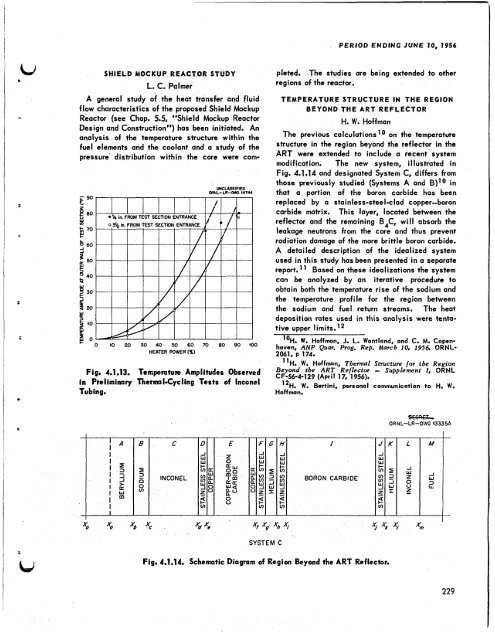ORNL-2106 - the Molten Salt Energy Technologies Web Site
ORNL-2106 - the Molten Salt Energy Technologies Web Site
ORNL-2106 - the Molten Salt Energy Technologies Web Site
Create successful ePaper yourself
Turn your PDF publications into a flip-book with our unique Google optimized e-Paper software.
SHIELD MOCKUP REACTOR STUDY<br />
L. C. Palmer<br />
A general study of <strong>the</strong> heat transfer and fluid<br />
flow characteristics of <strong>the</strong> proposed Shield Mockup<br />
Reactor (see Chap. 5.5, "Shield Mockup Reactor<br />
Design and Construction") has been initiated. An<br />
analysis of <strong>the</strong> temperature structure within <strong>the</strong><br />
fuel elements and <strong>the</strong> coolant and a study of <strong>the</strong><br />
pressure distribution within <strong>the</strong> core were com-<br />
UNCLASSIFIED<br />
<strong>ORNL</strong>-LR-W 14744<br />
- o io 20 30 40 50 60 m 80 90 (00<br />
HEATER POWER (XI<br />
.T'<br />
' FU f<br />
' Y<br />
Fig. 4.1.13. Temperatwe Amplitudes Observed<br />
in Preliminory Thermal-Cycling Tests of lnconel<br />
Tubing.<br />
PERIOD ENDING JUNE 10, 1956<br />
pleted. ,The studies are being extended to o<strong>the</strong>r<br />
regions of <strong>the</strong> reactor.<br />
TEMPERATURE STRUCTURE IN THE REGION<br />
BEYONDTHEARTREFLECTOR<br />
H. W. Hoffman<br />
The previous calculations10 on <strong>the</strong> temperature<br />
structure in <strong>the</strong> region beyond <strong>the</strong> reflector in <strong>the</strong><br />
ART were extended to include a recent system<br />
modification. The new system, illustrated in<br />
Fig. 4.1.14 and designated System C, differs from<br />
those previously studied (Systems A and 8)'O in<br />
that a portion of <strong>the</strong> boron carbide has been<br />
replaced by a stain les s-stee I-c lad copper-boron<br />
carbide matrix. This layer, located between <strong>the</strong><br />
reflector and <strong>the</strong> remaining B4C, will absorb <strong>the</strong><br />
leakage neutrons from <strong>the</strong> core and thus prevent<br />
radiation damage of <strong>the</strong> more brittle boron carbide.<br />
A detailed description of <strong>the</strong> idealized system<br />
used in this study has been presented in a separate<br />
report. Based on <strong>the</strong>se idealizations <strong>the</strong> system<br />
can be analyzed by an iterative procedure to<br />
obtain both <strong>the</strong> temperature rise of <strong>the</strong> sodium and<br />
<strong>the</strong> temperature profile for <strong>the</strong> region between<br />
<strong>the</strong> sodium and fuel return streams. The heat<br />
deposition rates used in this analysis were tenta-<br />
tive upper Iirnits.12<br />
'OH. W. Hoffman. J. L. Wantland. and C. M. CoDenhoven,<br />
ANP Quar.-Prog. Rep. March 10, 1956, <strong>ORNL</strong>-<br />
2061, P 174.<br />
"H. W. Hoffman, Thermal Structure /or <strong>the</strong> Region<br />
Beyond <strong>the</strong> ART Reflector - Supplement I, <strong>ORNL</strong><br />
CF-56-4-129 (April 17, 1956).<br />
12H. W. Bertini, personal communication to H. W.<br />
Hoffman.<br />
sEGRE;L.<br />
<strong>ORNL</strong>-LA-DWG 43U5A<br />
x, x, 3 % %% xf xg xh 4 $34 x*<br />
SYSTEM C<br />
Fig. 4.1.14. Schematic Diagram of Region Beyond <strong>the</strong> ART Reflector.<br />
I<br />
229



![Review of Molten Salt Reactor Physics Calculations [Disc 2]](https://img.yumpu.com/21979492/1/190x247/review-of-molten-salt-reactor-physics-calculations-disc-2.jpg?quality=85)













